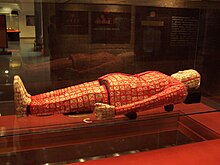Han conquest of Nanyue
| Han conquest of Nanyue | |||||||
|---|---|---|---|---|---|---|---|
| Part of thesouthward expansion of the Han dynasty | |||||||
 Map showing the expansion of the Han dynasty in the 2nd century BC | |||||||
| |||||||
| Belligerents | |||||||
| Han dynasty | Nanyue | ||||||
| Commanders and leaders | |||||||
|
Lu Bode Yang Pu |
Zhao Jiande Lü Jia | ||||||
| Strength | |||||||
| 100,000 | Unknown | ||||||
TheHan conquest of Nanyuewas a military conflict between theHan Empireand theNanyuekingdom in modernGuangdong,Guangxi,andNorthern Vietnam.During the reign ofEmperor Wu,Imperial Han military forces formally launched a punitive campaign against Nanyue and successfully conquered it in 111 BC.
Background[edit]
During the collapse of theQin dynasty,Zhao Tuoestablished himself as the King of Nanyue in southern China.[1][2]Zhao was originally a Qin military officer fromZhendingin northern China.[2]The Han frontier in the south was not threatened and there was no indication that Zhao Tuo would encroach on Han territory.[1]In 196 BC, theEmperor GaozusentLu Jiaon a diplomatic mission toNanyueto officially recognize Zhao Tuo as a local ruler.[1]Nevertheless, relations between Han and Nanyue were sometimes strained.[3]Zhao Tuo resentedEmpress Lü's ban on exports of metal wares and female livestock to Nanyue.[3]In 183 BC, he proclaimed himself the "Martial Emperor of the Southern Yue" ( Nam Việt Võ Đế ), which implied a perceived status on equal footing with the Han emperor.[4]Two years later, Nanyue attacked theChangsha Kingdom,a constituent kingdom of the Han empire.[4]In 180 BC, Lu Jia led a diplomatic mission to Nanyue.[3]During negotiations, he succeeded in convincing Zhao Tuo to give up on his title as emperor and pay homage to Han as a nominal vassal.[3]

In 135 BC, KingZhao Moof Nanyue appealed to the Han court for help against attackingMinyueforces.[5]The Han court responded swiftly and this led to Zhao Mo's agreement to send his son, PrinceZhao Yingqi,to serve in the palace atChang'an.[6]Even though Nanyue neglected to pay regular homage to the Han court, the court had its attention focused on other commitments and was not set on forcing the issue.[5]
At the Nanyue court in 113 BC, the Queen Dowager of Nanyue suggested incorporating Nanyue as a kingdom under the suzerainty of the Han empire, thus formally integrating the kingdom on the same terms as the other constituent kingdoms of the Han empire.[6]She was Han Chinese stock herself and was married toZhao Yingqi.[6]However, many Nanyue ministers opposed this suggestion.[6]Lü Jiawas the primary Nanyue official to oppose the idea and he led the opposition against the Queen Dowager.[5]In 112 BC, the opposition retaliated violently and executed the Queen Dowager, a provocation that led to the mobilization of a large Han naval force into Nanyue.[5]
Course[edit]
The Han forces comprised six armies, who traveled by sea, directly southward, or fromSichuanalong theXi River.[7]In 111 BC, GeneralLu Bodeand General Yang Pu advanced towardsPanyu(present-dayGuangzhou).[5]This resulted in the surrender of Nanyue to the Han empire later that year.[5]
Aftermath[edit]
Following the conquest of Nanyue in 111 BC, the Han empire established nine newcommanderiesto administer the former Nanyue territories.[5]The Han government proceeded toextendits imperial controlexpand further southwestwardby military means after the conquest.[8]Following the conquest, the Han empire gradually extended its overseas trade with the various polities inSoutheast Asiaand around the Indian Ocean.[9]
See also[edit]
References[edit]
Literature[edit]
- Loewe, Michael (1986). "The Former Han Dynasty". InTwitchett, Dennis;Loewe, Michael(eds.).The Cambridge History of China, Volume 1: The Ch'in and Han Empires, 221 BC–AD 220.Cambridge:Cambridge University Press.ISBN978-0-521-24327-8.
- Loewe, Michael (1986). "The Structure and Practice of Government". InTwitchett, Dennis;Loewe, Michael(eds.).The Cambridge History of China, Volume 1: The Ch'in and Han Empires, 221 BC–AD 220.Cambridge:Cambridge University Press.ISBN978-0-521-24327-8.
- Morton, W. Scott; Lewis, Charlton M. (2004).China: Its History and Culture(4th ed.). New York: McGraw-Hill.ISBN0-07-141279-4.
- Yü, Ying-shih (1986). "Han Foreign Relations". InTwitchett, Dennis;Loewe, Michael(eds.).The Cambridge History of China, Volume 1: The Ch'in and Han Empires, 221 BC–AD 220.Cambridge:Cambridge University Press.ISBN978-0-521-24327-8.

